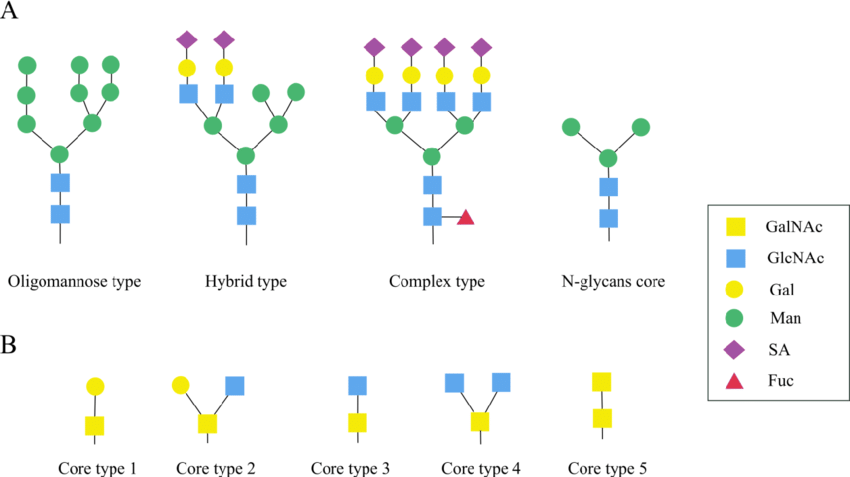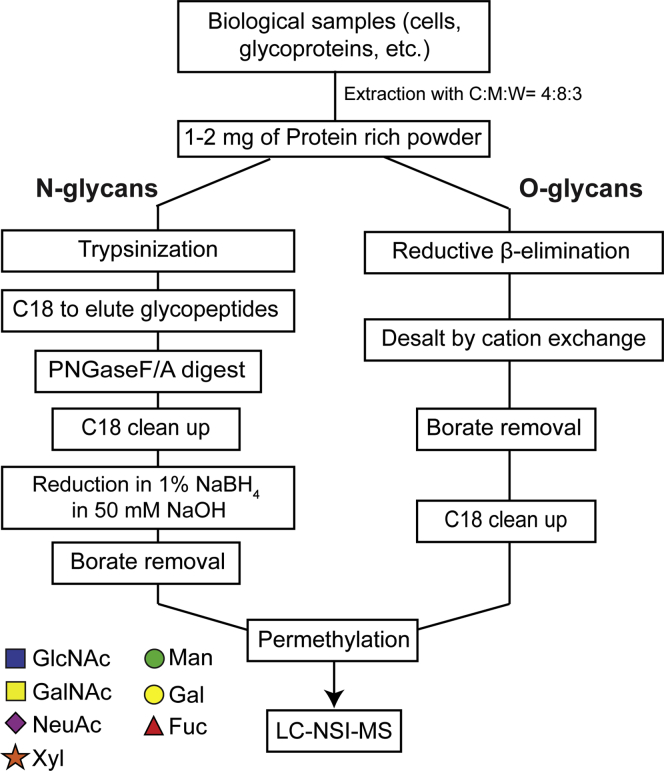Glycan Linkage Type Analysis Service
Glycan linkage type analysis involves the systematic identification and characterization of glycosidic linkages between monosaccharide units within glycan structures. As a critical component of glycomics research and glycosylation mechanism studies, this analysis helps determine not only the position of the glycosidic bond and its anomeric configuration (α or β), but also the nature of the linking atom (e.g., O, N, C, or S) and the overall spatial conformation. These structural insights are essential for understanding glycan stability, molecular recognition processes, and their roles in signal transduction pathways.
Depending on the type of linking atom, glycan linkages can be categorized as:
· O-Glycosidic Linkages: Connected via oxygen atoms; the most common type of glycosidic bond, especially prevalent in O-linked glycoproteins.
· N-Glycosidic Linkages: Connected via nitrogen atoms, typically found in N-linked glycosylation at asparagine residues.
· C-Glycosidic Linkages: Involving carbon-carbon bonds; structurally stable and commonly found in natural products.
· S-Glycosidic Linkages: Linked via sulfur atoms; relatively rare, usually observed in microbial metabolites.

Trzyna, A. et al. Eur J Clin Exp Med. 2020.
Figure 1. The Basic Structures A) N-glycans B) O-glycans
MtoZ Biolabs offers a high-resolution, high-accuracy Glycan Linkage Type Analysis Service powered by integrated multi-platform analytical strategies. Our Glycan Linkage Type Analysis Service supports glycan structure elucidation, isomer discrimination, bioactivity mechanism studies, and product quality control.
Analysis Workflow
MtoZ Biolabs offers Glycan Linkage Type Analysis Service to accurately identify glycosidic bond types, including linkage positions, α/β configurations, and O-, N-, C-, or S-linkages. Suitable for N-glycans, O-glycans, glycolipids, and synthetic glycans, this service enables clear differentiation of structural isomers. The analysis workflow is outlined below.
1. Sample Preparation and Purification
Samples are enzymatically digested, reduced, and desalted to retain critical linkage information while ensuring compatibility with downstream derivatization and separation techniques.
2. Selective Enzymatic Digestion
Specific glycosidases (e.g., α- or β-selective enzymes) are employed to probe glycosidic bond positions and stereochemistry, aiding structural inference.
3. Derivatization and Labeling
Methylation, reductive amination, or fluorescent tagging is performed to improve signal stability and enhance structural resolution during MS, chromatography, or electrophoresis analysis.
4. Multi-Platform Structural Characterization
LC–MS/MS: Enables high-throughput separation and linkage site identification
MALDI-TOF MS: Rapidly determines glycan composition and key fragment ions
ESI-MS/MS: Suited for isomer resolution and in-depth fragmentation analysis
NMR (1D/2D): Provides high-precision configuration and bond position data (e.g., COSY, HSQC)
CE-LIF: Employs capillary electrophoresis with laser-induced fluorescence for linkage isomer analysis
5. Data Processing and Annotation
We use specialized glycomics software such as GlycoWorkbench and SimGlycan, along with reference databases, to identify linkage types, resolve isomers, and reconstruct glycan structures with annotated graphical reports.

Kurz, S. et al. Mol. Cell. Proteomics. 2021.
Figure 2. General Workflow for Preparation of N- and O-glycans
Why Choose MtoZ Biolabs?
✔ Broad Coverage of Linkage Types: Our service accurately identifies O-, N-, C-, and S-glycosidic bonds along with α/β configurations, offering full compatibility with complex natural and synthetic glycans.
✔ Multi-Dimensional Analytical Platforms: We integrate advanced techniques including chromatography, MS (ESI, MALDI), NMR, and CE to provide comprehensive structural information from multiple perspectives.
✔ High-Resolution Isomer Differentiation: Our workflow is especially effective for resolving linkage isomers such as 1→3 vs. 1→4, overcoming limitations of traditional methods in site-specific identification.
✔ Expert Glycomics Support: Our team of experienced glycan biologists and MS specialists offers full-cycle support from project consultation to result interpretation.
✔ One-Time-Charge: Our pricing is transparent, no hidden fees or additional costs.
Sample Submission Suggestions
Glycan Linkage Type Analysis Service is compatible with a wide range of sample types, including glycoproteins, free glycans, tissue extracts, cell lysates, and biological fluids (e.g., serum, plasma, urine). Sample amount and handling requirements vary by project. Please contact our technical team for a complimentary submission guide tailored to your specific application.
FAQ
Q1: How does the service handle complex glycans with multiple isomers?
We combine high-resolution chromatographic techniques (e.g., HILIC, PGC) with ESI-MS/MS and multi-stage MS (MSⁿ) to separate and characterize isomeric structures. Structural reconstruction is performed using informatics tools like GlycoWorkbench, enabling precise identification of glycosidic linkage patterns.
Q2: Can this service support biomarker discovery or disease model studies?
Absolutely. Our platform allows comparative glycan linkage profiling between conditions (e.g., disease vs. control), facilitating the identification of differential linkage signatures for biomarker screening, target validation, or glycosylation consistency assessments in antibody development.
If your research involves investigating glycan linkage patterns, exploring structural biology mechanisms, or supporting biopharmaceutical development, MtoZ Biolabs is your ideal partner. With our advanced platforms and rigorous workflow, we deliver precise and insightful Glycan Linkage Type Analysis Service to accelerate your scientific and translational goals.
Related Services
Glycan Linkage Position Analysis Service
How to order?







